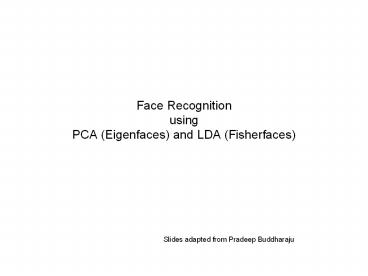Face Recognition using PCA (Eigenfaces) and LDA (Fisherfaces) - PowerPoint PPT Presentation
1 / 19
Title:
Face Recognition using PCA (Eigenfaces) and LDA (Fisherfaces)
Description:
A N x N pixel image of a face, represented as a vector occupies a single point ... IF ? ?c AND ?k*=mink{ ?k} ?c. then input image contains the face of individual k ... – PowerPoint PPT presentation
Number of Views:2059
Avg rating:3.0/5.0
Title: Face Recognition using PCA (Eigenfaces) and LDA (Fisherfaces)
1
Face Recognition using PCA (Eigenfaces) and LDA
(Fisherfaces)
- Slides adapted from Pradeep Buddharaju
2
Principal Component Analysis
- A N x N pixel image of a face,
represented as a vector occupies a single
point in N2-dimensional image space. - Images of faces being similar in overall
configuration, will not be randomly
distributed in this huge image space. - Therefore, they can be described by a low
dimensional subspace. - Main idea of PCA for faces
- To find vectors that best account for variation
of face images in entire image space. - These vectors are called eigen vectors.
- Construct a face space and project the images
into this face space (eigenfaces).
3
Image Representation
- Training set of m images of size NN are
represented by vectors of size N2 - ?1,?2,?3,,?M
- Example
4
Average Image and Difference Images
- The average training set is defined by
- ? (1/M) ?Mi1 ?i
- Each face differs from the average by vector
- Fi Gi ?
5
Covariance Matrix
- A covariance matrix is constructed as
- C AAT, where AF1,,FM of size N2 x
N2 - Finding eigenvectors of N2 x N2 matrix is
intractable. Hence, use the matrix ATA of size M
x M and find eigenvectors of this small matrix. -
Size of this matrix is N2 x N2
Size of this matrix is MM
6
Eigenvalues and Eigenvectors - Definition
- If v is a nonzero vector and ? is a number such
that - Av ?v, then
- v is said to be an eigenvector of A with
eigenvalue ?. - Example
l
(eigenvalues)
(eigenvectors)
A
v
7
How to Calculate Eigenvectors?
8
Eigenvectors of Covariance Matrix
- The eigenvectors vi of ATA are
- Consider the eigenvectors vi of ATA such that
- ATAvi ?ivi
- Premultiplying both sides by A, we have
- AAT(Avi) ?i(Avi)
9
Face Space
- The eigenvectors of covariance matrix are
- ui Avi
Face Space
- ui resemble facial images which look ghostly,
hence called eigenfaces
10
Projection into Face Space
- A face image can be projected into this face
space by - Ok UT(Gk ?) k1,,M
Projection of Image1
11
Recognition
- The test image, G, is projected into the face
space to obtain a vector, O - O UT(G ?)
- The distance of O to each face class is defined
by - ?k2 O-Ok2 k 1,,M
- A distance threshold,?c, is half the largest
distance between any two face images - ?c ½ maxj,k Oj-Ok j,k 1,,M
12
Recognition
- Find the distance, ? , between the original
image, G, and its reconstructed image from the
eigenface space, Gf, - ?2 G Gf 2 , where Gf U O ?
- Recognition process
- IF ??cthen input image is not a face image
- IF ?lt?c AND ?k?c for all k then input image
contains an unknown face - IF ?lt?c AND ?kmink ?k lt ?c then input
image contains the face of individual k
13
Limitations of Eigenfaces Approach
- Variations in lighting conditions
- Different lighting conditions for enrolment and
query. - Bright light causing image saturation.
- Differences in pose Head orientation
- - 2D feature distances appear to
distort. - Expression
- - Change in feature location and shape.
14
Linear Discriminant Analysis
- PCA does not use class information
- PCA projections are optimal for reconstruction
from a low dimensional basis, they may not be
optimal from a discrimination standpoint. - LDA is an enhancement to PCA
- Constructs a discriminant subspace that minimizes
the scatter between images of same class and
maximizes the scatter between different class
images
15
Mean Images
- Let X1, X2,, Xc be the face classes in the
database and let each face class Xi, i 1,2,,c
has k facial images xj, j1,2,,k. - We compute the mean image ?i of each class Xi as
- Now, the mean image ? of all the classes in the
database can be calculated as
16
Scatter Matrices
- We calculate within-class scatter matrix as
- We calculate the between-class scatter matrix as
17
Projection
- We find the product of SW-1 and SB and then
compute the Eigenvectors of this product (SW-1
SB) - AFTER REDUCING THE DIMENSION OF THE FEATURE
SPACE. - Use same technique as eigenfaces approach to
reduce the dimensionality of scatter matrix to
compute eigenvectors. - Form a matrix U that represents all eigenvectors
of SW-1 SB by placing each eigenvector ui as each
column in that matrix. - Each face image xj ? Xi can be projected into
this face space by the operation - Oi UT(xj ?)
18
Testing
- Same as Eigenfaces Approach
19
References
- Turk, M., Pentland, A. Eigenfaces for
recognition. J. Cognitive Neuroscience 3 (1991)
7186 - Belhumeur, P., P.Hespanha, J., Kriegman, D.
Eigenfaces vs. fisherfaces recognition using
class specific linear projection. IEEE
Transactions on Pattern Analysis and Machine
Intelligence 19 (1997) 711720































